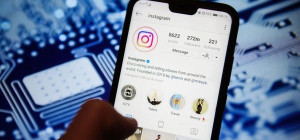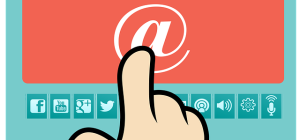Whether you’re crafting a new blog post, designing a social media campaign, or evaluating web analytics to find out more about your target audience – the basic objective for every marketing specialist remains the same, attracting high-quality prospects to their business.
Of course, that’s easier said than done in today’s media-saturated landscape.
Modern consumers are subjected to an unprecedented volume of marketing noise across their laptops, smartphones, and TV screens. Studies estimate that the average American is exposed to around 4,000 pieces of advertising on a daily basis.
The competing signals aren’t just coming from rivals in your industry or locality either. They’re coming from billion-dollar entities like Netflix, Amazon, YouTube and more. The result is a growing population of digitally-savvy individuals with shortened attention spans and a plethora of choices at their fingertips.
With these kinds of forces in play, less established brands have to work harder than ever before to separate themselves from the pack and create a truly unique proposition for your ideal customers. This is where great content can make a huge difference.
Why Content Drives Every Stage of Your Sales Funnel
Traditionally, the path to conversion followed a fairly linear route. An individual would recognize a pain point which needed to be addressed. They would gather information about different businesses that could service this need, and then they would identify a particular product or service that met their requirements in terms of pricing and quality.
Today, the same buyer typically spends a far greater portion of their time researching different brands through both offline and online channels on multiple devices, before they ever reach a purchasing decision. At each touchpoint, consumers will expect you to have detailed information available for their perusal, with consistent branding and messaging across each platform.
However, statistics and insights won’t win you conversions on their own. You also need to ensure that your content is optimized for each stage of the buyer’s journey.
Think of it this way; in the same way that a salesperson knows better than to close a client at the start of a pitch, a digital marketer should understand that a text-heavy case study isn’t going to entice a new website visitor that’s just learned about their business.
If you can combine these two elements together and focus them in the right direction, then you have the opportunity to become a truly dominant force in your niche.
In this primer, I will talk you through a variety of content strategies that have proved to be highly effective in attracting, qualifying, and finally converting leads.
Stage 1: Grabbing Attention and Raising Awareness
While you do want to attract more traffic to your website and social media accounts, a high volume of unqualified visitors will do nothing to shift your revenues upward.
A prime example of this principle is the low-value links that you see in the referrals section of websites like Huffington Post and Forbes.
While these websites may draw significant amounts of traffic, due to their clickbait headlines – only a very small percentage of users that end up the related blogs or landing pages will be interested in actually purchasing products from these companies.
Actionable Steps
Find Your Target Audience
There are a number of valuable resources that you can use to help you find your target audience.
- Direct questionnaires mailed out to your existing customers. If you have a sizeable following on social media then you can set up online surveys for your followers as well. Key details to cover include demographic information, purchasing preferences, pain points, occupation, company size, and preferred channels for brand interactions (smartphone, laptop, store visits)
- Talk to your sales and support team to determine which clients they value most highly, and the types of leads that generally lead to dead-ends.
- Analyze your sales figures and to identify any patterns in terms of where the majority of your revenues are coming from and the types of customers that are initiating those buys. Social media and web analytics will also provide a wealth of information in this regard.
- Work backwards from your brand values, and figure out which audiences are most likely to respond to the products and services you put out.
Once you have a good amount of data at your disposal, you can build two or three profiles for your ideal customer.
Make sure that each of these profiles targets a different segment and that you have clearly identified the needs of each one. You should also create at least one negative persona, which shows the type of lead you absolutely want to avoid.
Once you have buyer personas in place, you must spend some time building a bucket of search terms around these individuals. Focus on long-tail keywords that are likely to lead prospects directly to your business.
Now, you can start creating raising awareness.
Nerd Fitness is a brand that understands its audience and puts out extremely well-aligned content
Offer Value
At the start of the funnel, people are looking for engaging content that is relevant to their interests.
While quality is important at each stage of the buyer’s journey, it is especially critical here. When these individuals click on one of your blogs or eBooks, they’re not making decisions on whether to buy your products; they’re figuring out whether your website is worth a few extra minutes of their attention.
You can convince readers through:
- Well-researched, keyword-optimized blog posts. Depending on the type of audience you are looking to attract you could focus on general recommendations for your target audience, or you try to position your firm at the forefront of the industry with insightful content that tackles hot button issues in your chosen space.
- News roundups or longform reporting on industry-specific topics.
- An employee-driven podcast.
- Creating a brand community by integrating user-submitted content and social media feedback into your frontline strategy.
- Video content that emphasizes storytelling and entertainment over detailed information.
AirBnB’s YouTube page features stories beautifully filmed personal stories from hosts all over the world
How Glossier Used Content to Build Brand Awareness
Compare this approach to a brand like Glossier. Company owner Emily Weiss, managed to build a multi-million dollar beauty empire off the back of a diversified and highly engaging content marketing strategy that was targeted towards a very specific niche of customers.
Before Weiss began creating and selling her own products, she ran a popular blog called Into the Gloss that demystified many aspects of the otherwise secretive beauty industry. Early on, she established reputations for securing interviews with massive names in this space including the likes of Kim Kardashian and Karlie Kloss.
As the blog’s following grew, and readers began to clamor for more grounded and inclusive cosmetics Weiss decided to respond to their engagement by launching Glossier.
She introduced the company’s first product, a face wash called the Milk Jelly Cleanser, with a blog post detailing the motivation and process behind the product. She also sent out a sample of the cleanser to a selective cross sample of fans and encouraged them to send in pictures of them using the product. These pictures were then posted to Glossier’s social media account.
Stage 2: Qualify Leads and Support Evaluation
Once an individual has bought in to your brand philosophy and has begun to actively seek out further content on your website, you can begin to target them with more specific content that is designed to reveal their intent. In other words, you want to find out whether a visitor is simply looking to browse your blogs and videos or if they actually considering buying your products and services.
Lead magnets are the perfect vehicle for qualifying users at the middle stage of the sales funnel. Creating a lead magnet is easy, come up with a high-quality piece of content that you can offer to your website visitors free-of-charge and ask them to provide an email address and other contact information in return.
The product that you attach to the lead magnet should aim to resolve a real problem that your prospective customer is facing. If you can communicate this value effectively, then the prospect will be compelled to provide a small token reward in return. Small reciprocal transactions serve as the first step in a long-term sales relationship.
Now, this value doesn’t necessarily need to come from a lengthy E-book or complex white paper. A package of useful links or a longform case study that provides original research to support information contained within a blog post can be more than enough to get your visitor to offer up their details. If you’re struggling to create high quality blog posts, you should consider hiring blog writers for your brand.
Self-help guru Tim Ferris draws in millions of visitors every month with his weekly podcast, then provides more personal insights to listeners that are truly aligned with his philosophy. The listicle attached to this lead magnet isn’t exhaustive by any means, but to the right lead this is exactly the kind of information they need.
However, after you’ve secured a buy-in you will need to work a little harder to move qualified leads through to a final decision.
By the time they’ve entered your mailing list, most prospects will already be well aware of your brand’s values and unique selling points. Now, you have to show them how you trump the competition. At this stage, you really want to dive deep into your products and services, and detail real ways that they can benefit potential customers.
Global IT consultancy Gartner, uses webinars to showcase their expertise to business clients.
Telecommunications giant Cisco uses detailed case studies to demonstrate their effectiveness to potential clients.
Stage 3: Encourage the Conversion
A lot of content marketers stress the importance of a clear “Call to Action”, but inciting a cold prospect to buy your products is only likely to come off as sleazy.
However, once you’ve shepherded a lead down to the very bottom of your funnel you can feel free to lay on your sales pitch as thickly as possible. At this stage, you want to stress the features and pricing of your product in very direct terms, in an email or landing page that is designed to produce immediate action.
The classic multi-tiered plan comparison template is extremely effective for getting all of your sales information across in a concise manner
Remember, you’re trying to compel customers to make an immediate buying decision, so you can’t rely on vague, feel-good copywriting that say a lot without actually communicating anything of value. Every part of your direct response marketing should be concise, clear and urgent, with no room for misinterpretation. Also, make sure to make sure to include direct instructions explaining the steps a customer has to follow to purchase your product or service.
It might seem gimmicky but a large highlighted link that tells the prospect to BUY NOW will do wonders for your conversion rate.
Excellent design can elevate even the simplest message
However, if your final push for a conversion doesn’t receive an immediate follow-up from a seemingly ideal customer, then don’t despair. Take a leaf from larger companies’ branding efforts and simply keep your marketing circulating in and around these prospects so that they can come to a purchasing decision on their own in due time.
In the digital era, attention spans are short and memories are even shorter. No matter how interested your customer might be now, a few days in between may be enough to turn them towards an equally appealing competitor. By keeping your product/services front and center in their mind, you can ensure that when it does come time to buy, your business will be at the front of the line.
















